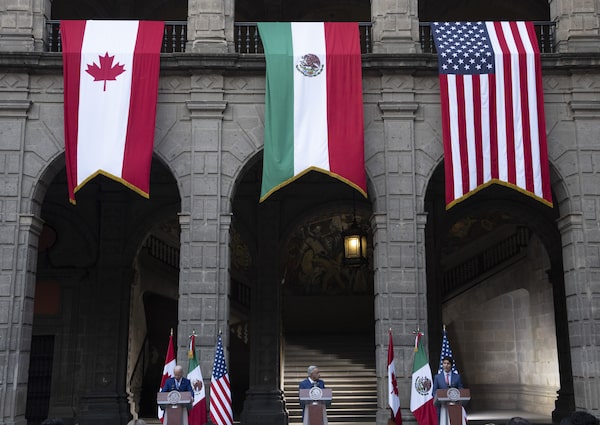
U.S. President Joe Biden, left, and Mexican President Andrés Manuel López Obrador, centre, listen to Prime Minister Justin Trudeau speak at the North American Leaders Summit, in Mexico City, on Jan. 10, 2023.Adrian Wyld/The Canadian Press
Darryl White is chief executive of BMO Financial Group. Ian Bremmer is president and founder of Eurasia Group and GZERO Media.
Trade negotiations – even between the closest of friends – are full of competing interests. For the United States and Canada, the fast-approaching review of the United States-Mexico-Canada Agreement (USMCA) will be crucial to maintaining a global leadership position and high quality of life for 380 million people amid increasing competition from current and emerging global powers.
While the 2026 review of the USMCA may seem far away, with a U.S. presidential election and a Canadian federal election in the meantime, complacency amounts to sleepwalking.
The rules governing trade between Canada and the United States drive economic growth because of the consumer value they deliver, and the predictability they provide businesses. These trade rules work because countries agree to live by them and settle their disputes through them. And as the American and Canadian experience with the last negotiation showed, when these rules are up for discussion it creates uncertainty for consumers and for the businesses they rely on.
Stakeholder politics become thorny, politicians are pressured to stand strong for the home front, and economic sectors fear becoming the sacred cow offered up in the name of national interest. And while the USMCA has just three signatories, the U.S.-China relationship looms large among nearly every bilateral and trilateral issue to be considered.
Six months out from the 2024 presidential election is an opportune moment to reflect on what is needed for the 2026 review of USMCA to deliver a winning outcome for Canada and the United States. This involves setting clear, mutually beneficial priorities, and creating the political conditions for success.
Let’s start with the priorities.
Since the bilateral trade pacts of the 1960s and the North American free-trade agreement that followed them, Canada-U.S. supply chains have benefited from the tariff-free treatment of most goods. This reduces trade frictions that hamper productivity while supporting private-sector-led growth needed to fight inflation, deliver savings for consumers and engineer North America’s economic advantage.
Trade among the three countries has now surpassed the US$1.5-trillion mark, with Canada-U.S. trade comprising more than half of that. The Brookings Institution assesses this regional bloc as accounting for almost one-third of global GDP.
The Canada-U.S. relationship – the world’s most successful bilateral relationship – creates the conditions to produce the goods that American and Canadian consumers want at competitive prices. It supports the system that underpins the U.S. dollar as the world’s reserve currency and helps to secure market access to export opportunities abroad for businesses in both countries. And it does it by complementing each country’s strengths, making the whole greater than the sum of its parts.
Canadian and American entrepreneurs and businesses have local access to the natural resources in greatest global demand, with recent examples of Ottawa and Washington teaming up to support junior Canadian critical minerals companies being the latest of enhancements to strategic supply chain security.
This continental integration is so deep that in sectors such as automotive manufacturing, goods can cross the border seven times during their production life. From factory floors and research laboratories throughout Canada, the U.S. and Mexico, vehicles are built in North America, by North American employees, primarily through North American supply chains, and bought by North American consumers. We should expand these continental relationships as electric vehicles become more widely deployed.
Priorities also need to take into account a modernization agenda. Updating the list of professionals covered by the trade agreement’s labour mobility rules will ensure companies can move their talent cross-border where it’s needed, when it’s needed – and inspire labour market integration at the sub-national level. If two more G7 countries (not to mention the entire European Union) can achieve productivity-boosting labour mobility, surely there’s hope for Canadian provinces to get it done.
But the political conditions must be in place to deliver on those priorities.
Delivering that support in the current economic climate has become more challenging with increased skepticism as to whether trade has delivered the widespread benefits – especially those experienced by consumers – promoted by the original NAFTA’s champions.
In the face of increasing geopolitical competition to North America’s advantage, business and political leaders have a responsibility to promote this partnership in the run-up to national elections. Soon-to-be-reviewed cross-border agreements are a good place to start.
This time there are no excuses. The U.S., Canada and Mexico must come to the table prepared to face strengthening global competitors with a clear set of mutually beneficial priorities, and the political conditions in place to deliver them.